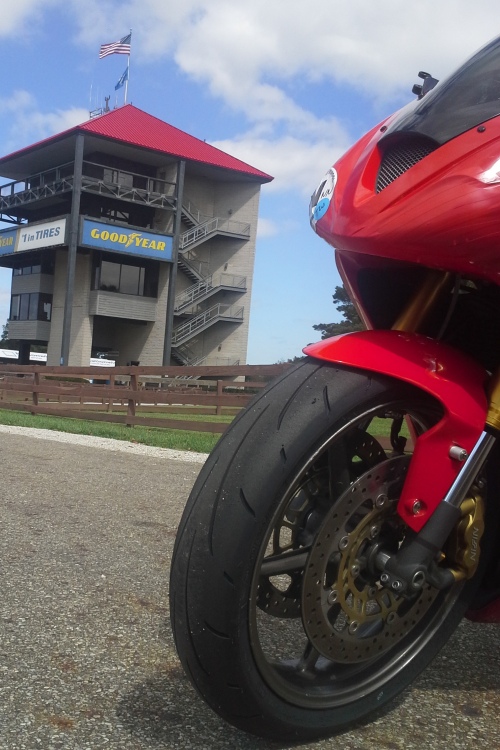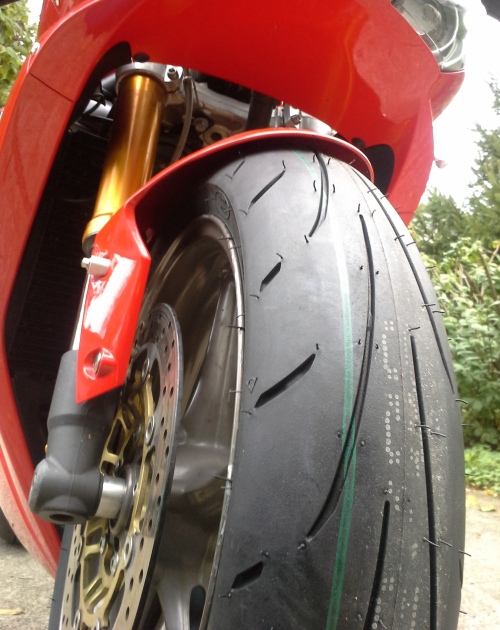
Bike taped, new tires mounted… ready for a day at the track.
Consider it one of those small victories in life that induce happiness: I recently did the best lap time on my local track that I’ve ever done on my Triumph Daytona 675.
No, I didn’t make any modifications to the bike. And since I’m on the high side of 50, and have been riding on the track for many years, it’s unlikely I suddenly found a new burst of speed or acquired long-missing skills. That only leaves one other variable: the new set of Dunlop Q3 tires I put on the Daytona right before I went to the track.
As much as I might want to take personal credit for lowering my lap time, I think I know where the credit needs to go. And even without the numbers on my lap timer, I’d still have the same verdict: I love these tires.
A little background. I’ve been using Dunlop sport tires on my bikes pretty consistently since the Qualifier came out almost a decade ago, but I’ve also used other tires and was always open to trying new offerings from other manufacturers.
Two years ago, SportRider magazine did a comparison test of sport tires suited for street use and the occasional track day (my riding profile on my Daytona) and the Q2 easily topped the list, despite being nearly the least expensive and oldest design. I was happy with the Q2s on my Daytona. So when Dunlop came out with the Q3 last year and said it was another big step forward, my skeptical side clicked into action. How could it be much better? Then I noticed that they were touting the benefits of putting carbon fiber in the sidewalls, and the little Joe Skeptic character who perches on my left shoulder and shouts into my ear was really getting agitated. Sounds like marketing BS to me!

Two things always make a big difference in feel: new tires and new running shoes. I never notice how the old ones have degraded until I put on fresh, new ones.
Then I read the first reviews of the Q3. I’ve been reading motorcycle and motorcycle gear reviews in magazines and on web sites long enough to be able to detect, at least somewhat, when the reviewer is trying to soften the blow of pointing out shortcomings. I’ve written some of those reviews myself. Plus, I know some of the guys writing those reviews, and there are certain ones I’m more inclined to believe.
The reviews were all positive. Positively glowing. Including the ones from the guys I trusted. A little of my skepticism crumbled. Enough that I was excited to try the Q3 for myself.
I try to do a couple of track days a year, but with my busier work and travel schedule this year, managing RevZilla’s original content initiative, I was stupid and put it off and didn’t get to the track until the beginning of September. I was hoping to get in one more track day this season, and I was holding off on writing this review until I had a second day’s worth of information, but the weather has killed that hope. Reminder to self: Next year, do better.
So, to finally get to the real point: The Q3s lived up to the glowing reviews. The good and bad of a fall track day in this area is that you can have beautiful, dry, sunny days, but the mornings can be really cool. In my first morning session, I was expecting some sliding on the cold track. I kept the pace cautious, but the Q3s didn’t slip a millimeter, as far as I could detect. They warmed up quickly, even on the cold asphalt, and threw no surprises my way. (If you’ve read the free sample chapter from my book, you know I’ve had bad experiences with tires that did surprise me.)
As the afternoon sun heated the track and traction got nice and sticky, the Dunlops maintained the same grip. I have been around Mid-Ohio a little faster on bigger bikes, but by the end of the day, my lap timer showed my best-ever time on the Daytona. And through it all, the Q3s never once got greasy or started sliding.
That would be benefit enough, but I was also amazed to see that the tires were showing very little wear at the end of the day. Even on the Q2, the feathering along the edge of the tread showed quite a bit of rubber being shed. Clearly, the Q3s are able to take all I am capable of dishing out and more.
Dunlop says the addition of carbon fiber in the sidewalls is intended to improve stiffness and feedback. The profile is designed to encourage quick steering, which is something the Daytona also provides. The combination for me, a humble intermediate track-day guy, was predictability, precise steering and fast response to inputs. The limiting factors were my skills, not the abilities of the bike or the tires. No wonder the result was my best lap yet on the Daytona.
Of course I won’t know the true longevity of the tires until I’ve put some street miles on them, but the early signs are encouraging. If they last as long as I suspect, and if they work as well in the rain as the other reviews suggest, then there’s no street-riding downside to the grip and performance they provide on the track.
To top it off, there are two other positives. The first is price. A set of the U.S.-made Dunlops in the typical sportbike sizes my Daytona uses costs less than $240, which is about what the predecessor Q2s cost. Plus, Dunlop has had some promotions offering a $40 rebate, if you buy a set of two, so watch for those deals.
The second positive may not matter to some of you, but it was a pleasant surprise to me. I change my own tires at home, so I was wondering if all that talk about stiff, carbon fiber-reinforced sidewalls would mean a real struggle to get these tires mounted on my rims. No worries. They spooned on with no more effort than usual.
Racers and expert-level riders, especially those on track-only bikes, may want to go with a DOT-legal race tire, like the GP-A Pro. But I think there are a lot more people out there like me: intermediate-level or novice-level riders on the track who also ride on the street and want a tire that works well in both environments. For us, the Q3 is the best tire yet.


I was thinking about getting these tires but I have heard of some people having problems with them tearing.
I have also read about several people who have had delamination problems. Some are speculating that too-low air pressure is partly to blame. I can’t honestly say whether that’s the case or there is a problem with the tires. Two positive things I can say: It seems Dunlop is standing behind the tires and offering replacements for people who have the problems, and second, many people just keep riding with the tires and find it’s not really a problem at all. It’s just a tear on the surface of the tire that doesn’t really affect its performance, and as the tire wears down, it “heals” and disappears as the torn piece of rubber wears away. On a separate issue, I do know personally of a guy who had a Q3 blister badly at a track day. I saw that one myself. It was a different issue. It was covered under warranty, too, and I have not heard of other cases like that.